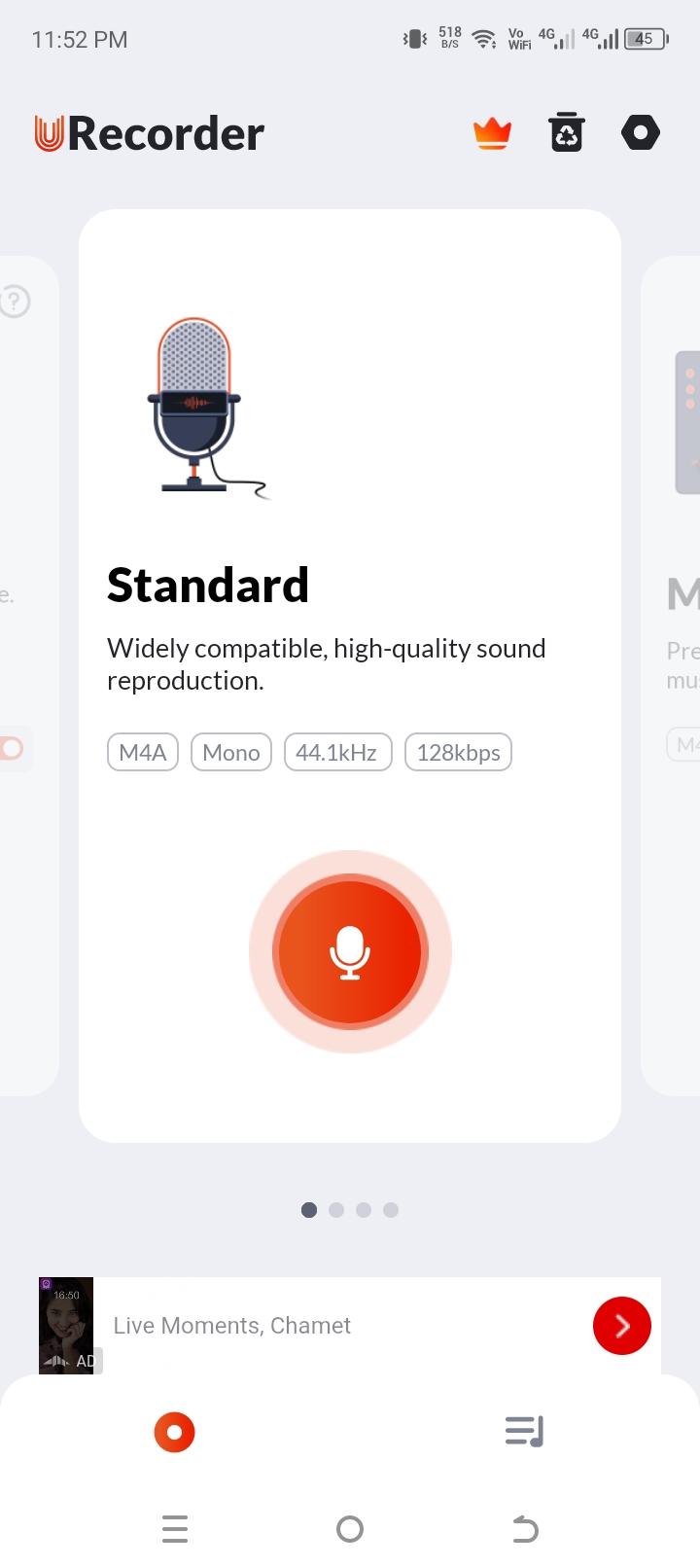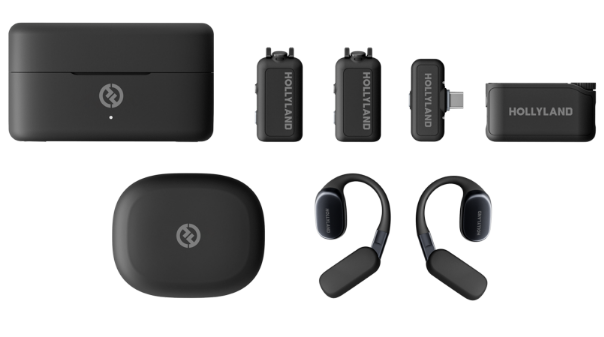When it comes to recording music, the quality of your microphone can make all the difference between a mediocre track and a masterpiece. With an array of options available, finding the best computer microphone tailored for music production can be daunting. Whether you’re laying down vocal tracks, capturing instruments, or simply looking for a crystal-clear recording, the right microphone ensures that every nuance and note is impeccably preserved. This listicle will guide you through the top picks for computer microphones designed especially for music, helping you to find the perfect match for your sonic ambitions without getting lost in the technical jargon.
When searching for the best computer microphone for music, it’s crucial to consider several key criteria to ensure that you make an informed decision.
Audio quality: Look for microphones that offer a high-resolution capture with clear highs, full mids, and solid lows, ensuring your vocals and instruments sound true to life.
Polar pattern: For music recording, cardioid patterns are common as they capture sound primarily from the front, minimizing background noise. However, for capturing a group or a more ambient sound, an omnidirectional or bidirectional pattern may be preferred.
Build quality and durability: Since music recording can sometimes involve travel or continuous handling, a robust build that can withstand some wear and tear is beneficial.
Connectivity options: USB microphones offer convenience and are typically easy to set up with computers, while analog microphones with XLR connections may require additional audio interfaces but often deliver professional-grade sound quality.
Additional features like onboard controls for volume, pattern switching, or a built-in headphone jack for live monitoring. These can significantly enhance your recording experience.
Now, let’s look at the top picks for the best computer microphones for music.
| Feature/Spec | Audio-Technica AT2020USB+ | Blue Yeti USB Microphone | Shure SM7B | Rode NT-USB | AKG Pro Audio C214 |
|---|---|---|---|---|---|
| Type of Microphone | Condenser | Condenser | Dynamic | Condenser | Condenser |
| Connection Type | USB | USB | XLR | USB | XLR |
| Polar Patterns | Cardioid | Cardioid, Bidirectional, | Cardioid | Cardioid | Cardioid |
| Omni-directional, Stereo | |||||
| Frequency Response | 20Hz – 20kHz | 20Hz – 20kHz | 50Hz – 20kHz | 20Hz – 20kHz | 20Hz – 20kHz |
| Price Range (prices may vary) | $$$ | $$ | $$$$ | $$$ | $$$$ |
| Additional Features | Mix control; Headphone jack | Mute button; Gain control; | Internal ‘air suspension’ | Pop shield; Tripod desk stand | Integrated suspension |
| Headphone jack | shock isolation; Pop filter | ; Ring mount | ; Carry case |
When comparing these microphones, consider what’s most important for your recording needs, such as the sound quality, the type of instruments or vocals you’re recording, and the recording environment. The best computer microphone for music will vary depending on individual needs and scenarios.
Audio-Technica AT2020USB+
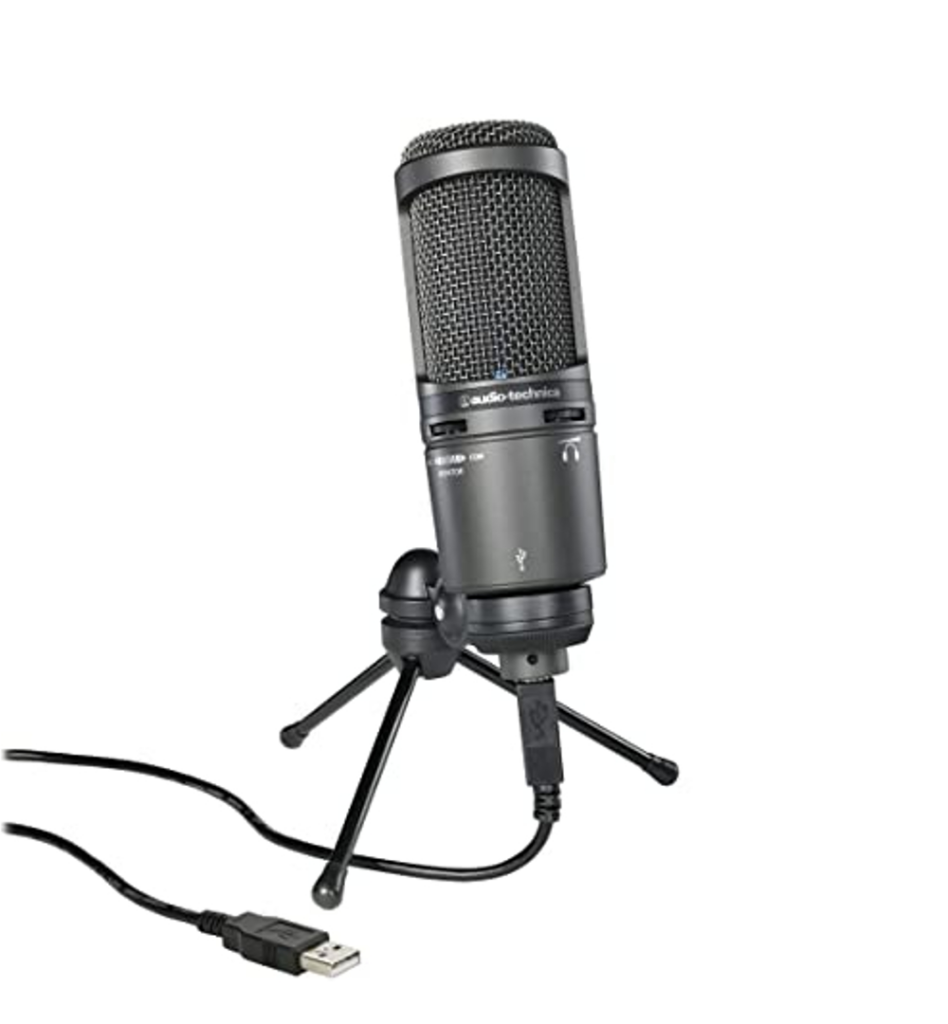
Overview:
The Audio-Technica AT2020USB+ is a microphone that has earned its stripes in the home recording and podcasting worlds, but it has also proven itself to be adept at capturing musical performances. It’s designed to deliver studio-quality articulation and intelligibility, which is a fancy way of saying it makes everything sound crystal clear. The AT2020USB+ features a built-in headphone jack with volume control that allows you to directly monitor your mic signal with no delay, which is crucial when recording music. Plus, its mix control allows you to blend your microphone signal with pre-recorded audio — a nice touch for singers or instrumentalists playing along to backing tracks.
Specs:
- Microphone Type: Condenser
- Polar Pattern: Cardioid
- Connectivity: USB
- Frequency Response: 20Hz – 20kHz
- Sample Rate: 44.1/48 kHz
- Bit Depth: 16 bit
- Controls: Headphone volume, mix control
- Compatible with: Windows and Mac OS
Pros:
- Excellent audio quality with a focus on clarity of vocals and instruments.
- Direct monitoring through the headphone jack eliminates latency issues.
- Very simple to use – essentially plug-and-play.
- Durable and well-constructed, indicative of longevity.
Cons:
- The USB connection limits experimenting with different preamps or audio interfaces.
- Its focused cardioid pattern may not be ideal for capturing a room’s ambience or recording multiple instruments simultaneously.
- Lack of onboard gain control can be inconvenient, requiring adjustments from the connected device.
Price:
Pricing for the Audio-Technica AT2020USB+ varies depending on the retailer, but you can typically expect it to sit somewhere in the mid-range bracket for USB microphones designed for music recording. It’s not the cheapest option out there, but its solid performance justifies the cost for serious musicians seeking quality on a budget.
Personal Opinion:
I’ve found the AT2020USB+ to be a trustworthy ally in home music production. The clarity of sound is truly impressive for a USB mic, handling both gentle acoustic tones and powerful vocal performances with ease. What I appreciate most is its recording fidelity, bringing a professional sheen to DIY recordings, which is something not every microphone at this price point can boast. It suits singers, podcasters, and instrumentalists alike, although I would caution against it if you’re looking to capture a more ‘roomy’ sound or the nuances of a live band setup. Overall, it’s a solid choice if you’re a solo artist or content creator focusing on quality single-source recordings.
Blue Yeti USB Microphone
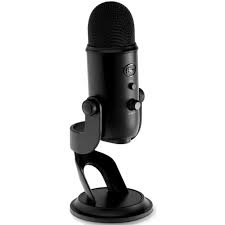
Overview:
The Blue Yeti is a well-recognized figure in the digital recording landscape, often celebrated for its versatility and ease of use, making it a favorite among podcasters, streamers, and musicians alike. As someone who appreciates crisp audio that captures the intricacies of vocal performances, the Blue Yeti stands out for its ability to deliver studio-quality sound without requiring an elaborate setup.
What sets this mic apart is the array of polar patterns you can choose from. Whether you’re holding an intimate acoustic session or recording a dynamic band rehearsal, the Yeti provides options such as cardioid, bidirectional, omnidirectional, and stereo—granting you the flexibility to match your recording scenario. The real beauty here is in the plug-and-play functionality; it’s a breeze to set up with its USB connection, meaning you’ll spend less time fiddling with gear and more time creating music.
Specs:
- Polar Patterns: Cardioid, Bidirectional, Omnidirectional, Stereo
- Frequency Response: 20Hz – 20kHz
- Sample Rate: 48 kHz
- Bit Rate: 16-bit
- Connection: USB
- Features: Mute button, Gain control, Zero-latency headphone output
Pros:
- User-friendly interface suitable for beginners and professionals
- Versatile recording patterns cater to a vast array of recording settings
- No-fuss setup with USB connectivity; compatible with both Windows and Mac
- Sturdy and stylish design ensures durability and aesthetic appeal on your desk
Cons:
- Its size and weight make it less portable compared to smaller microphones
- Can pick up background noises if not in the right setting; sensitive gain control
Price:
While I won’t quote an exact price, the Blue Yeti USB Microphone typically sits at a mid-range point that reflects its quality without being prohibitively expensive for the serious at-home musician. It represents a sweet spot between cost and performance – you are investing in a workhorse that will serve you well across various recording needs. Worth noting is that the investment is not just in the microphone itself but the convenience and quality it brings to your music creation process.
In summary, the Blue Yeti USB Microphone is a near-perfect blend of quality, flexibility, and ease of use. It’s an excellent choice for any musician looking to produce high-quality music without wading into the professional studio equipment territory. Its shortcomings are minor when weighed against its robust feature set and the beautiful, clear audio it captures.
Shure SM7B Cardioid Dynamic Microphone
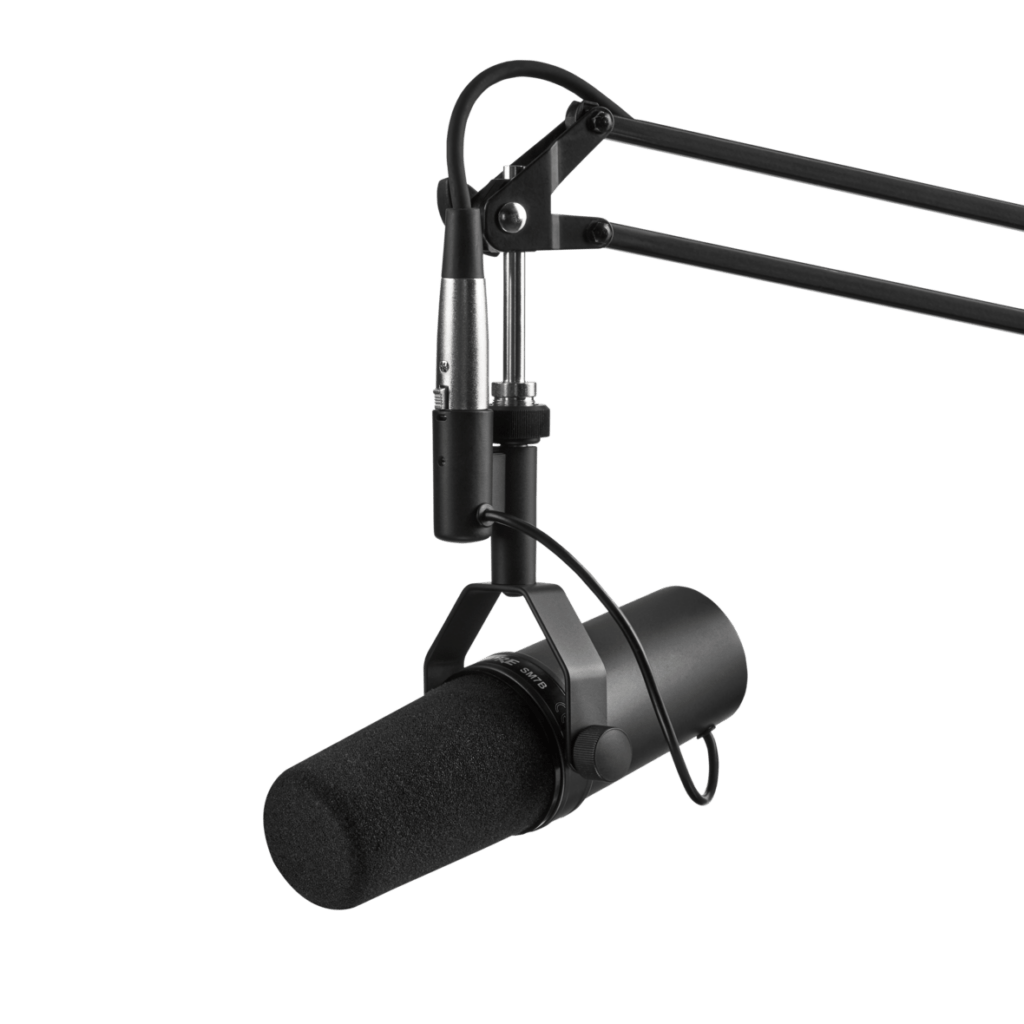
Overview:
The Shure SM7B is a microphone that’s wielded quite a reputation in the music industry, and for good reason. It’s a dynamic piece of gear that’s been spotted in countless studios worldwide—and if I might add, it’s not just for show.
From my experience, the SM7B excels at capturing both vocals and instruments with an almost obsessive level of detail. There’s something about how it respects the natural timbre of the sound that makes it an irreplaceable tool in a music creator’s arsenal. It bucks background noise and sidesteps the pesky interference that lesser mics flinch at. This is the microphone that, if microphones had a royalty system, would probably be sitting on the throne.
Specs:
- Type: Dynamic
- Polar Pattern: Cardioid
- Frequency Response: 50Hz to 20kHz
- Connectivity: XLR
- Impedance: 150 ohms
- Swappable windscreen
Pros & Cons:
Pros:
- The cardioid pattern is tight and focused, which means it picks up what you want and leaves out what you don’t.
- It’s built like a tank—durability is top-notch.
- The frequency response favors clarity and warmth, making it versatile for a range of musical styles.
- The included air suspension shock isolation and pop filter are life-savers for reducing mechanical noise and plosives.
- It’s become an industry standard, which speaks volumes to its reliability and performance.
Cons:
- Requires a decent preamp to get the best out of it, as its output is on the lower side.
- Not the cheapest option out there—you’re paying for professional quality.
- The XLR connection means you need additional gear (like an audio interface) to use it which can add to the cost if you don’t already have it.
Price:
Now here’s where it might sting a bit. The Shure SM7B is typically marked at a premium price point. It won’t be the most budget-friendly option on your list, usually retailing around $400. However, you’re investing in a microphone that doesn’t just do its job, but enhances your music. It’s a classic case of getting what you pay for, and with the SM7B, every penny is audible in the quality of the recordings.
Rode NT-USB
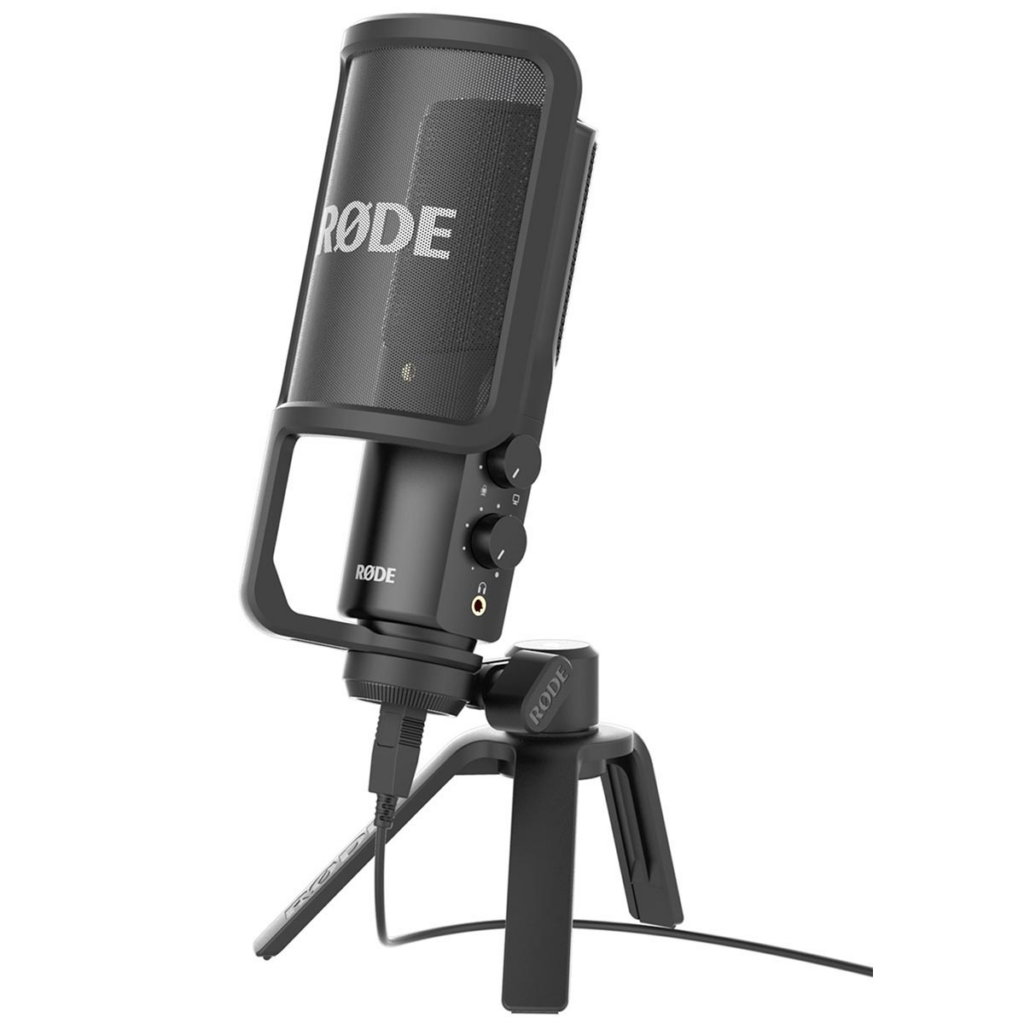
Overview:
The Rode NT-USB is a highly versatile side-address microphone that is ideal for recording musical performances as well as other audio creations like podcasts and voice-overs. It has a studio-grade quality that captures the essence of both vocals and instruments with crystal clear clarity. The inclusion of a pop-shield, tripod desk stand, ring mount, storage pouch, and a 6m USB cable makes this a very appealing package for musicians who appreciate a comprehensive recording solution.
From my personal experience, the Rode NT-USB impresses right out of the box. It has a solid build which immediately instills confidence in its longevity. Upon setting it up, which is a breeze, you’ll notice the convenience of having direct mix control between mic input and source output, ensuring real-time monitoring capabilities without any noticeable lag. The sound quality is sublime for a USB microphone; it’s rich, detailed, and has a warmth that you usually find in more expensive, professional studio microphones.
Specs:
- Acoustic Principle: Pressure Gradient
- Active Electronics: JFET impedance converter with bipolar output buffer, A/D converter 16bit 48kHz
- Frequency Range: 20Hz – 20kHz
- Maximum SPL: 110dB SPL
- Power Options: USB powered
- Resolution: 16-bit
- Connectivity: USB – plug and play connectivity for Mac and PC
- Direct Mix Control: On-mic mix control
Pros & Cons:
Pros:
- Excellent sound quality that remains true to Rode’s professional microphone lineage.
- Incredibly user-friendly, especially for those who aren’t familiar with professional audio equipment.
- The direct mix control is a godsend for real-time audio monitoring without latency issues.
- Comes with a full kit, reducing the need for additional accessories.
- Aesthetically pleasing design that feels robust and well-engineered.
Cons:
- Fixed 16-bit recording might be a deterrent for those needing higher resolution audio.
- The provided pop shield is decent, but for professional music recording, you might want something more substantial.
- If you’re moving it around a lot, not having a dedicated carrying case might be a slight drawback.
Price:
The Rode NT-USB typically retails for around $169, although prices may vary based on the retailer and geographic location. Given the quality and breadth of what’s included, it’s priced very competitively. In my opinion, the investment is justified for anyone seriously into their recording craft. It effectively bridges the gap between amateur and professional equipment, making it a great value proposition for the aspiring artist.
In conclusion, the Rode NT-USB stands as a testament to Rode’s reputation for creating top-notch recording equipment. Its ease of use, combined with the splendid audio fidelity, makes it a smart choice for musicians who want to capture studio-quality sound without the complexity or expense of high-end studio equipment.
AKG Pro Audio C214 Professional Large-Diaphragm Condenser Microphone
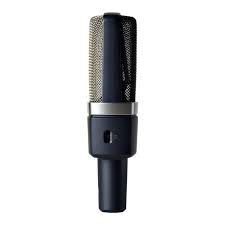
Overview:
The AKG Pro Audio C214 is a professional-grade condenser microphone that is known for its ability to capture clear, detailed sound with a warmth that is particularly suited to recording music. It is essentially a more affordable version of the highly revered C414, making it accessible to a broader range of musicians and producers. After spending some quality time with the C214, I was impressed by the build quality, which felt robust enough for both studio and stage use.
In practical terms, the C214 offers a stellar performance on a variety of sources – vocals, acoustic guitars, and even drum overheads. It delivered a well-balanced sound with a touch of that sought-after AKG character: crisp highs, and a solid, meaty bass response that didn’t overwhelm the mix. It handled high sound pressure levels admirably thanks to its 20dB attenuator, which means recording loud sources like guitar amps or brass instruments wasn’t an issue.
One aspect that stood out to me was the microphone’s low self-noise. For artists who record in less-than-ideal conditions or home studios, this can be a godsend. The mic’s ability to isolate the main sound source and reduce feedback with its cardioid pickup pattern also contributed to the clean recordings I achieved, making the C214 a very versatile tool in the microphone arsenal.
Specs:
- Polar Pattern: Cardioid
- Frequency Response: 20 Hz to 20 kHz
- Equivalent Noise Level: 13 dB-A
- Sensitivity: 20 mV/Pa (-34 dBV)
- Max SPL for 0.5% THD: 136/156 dB (0/-20 dB pad)
- Low Cut Filter: 160 Hz, 6 dB/octave
- Attenuation Pad: 0/-20 dB
- Phantom Power Requirement: 12 to 52 V phantom power to DIN/IEC
Pros & Cons:
Pros:
- Exceptional audio quality with a broad frequency response that captures every nuance of the performance.
- Sturdy build quality which instills confidence for long-term use.
- High SPL handling capability; perfect for loud instruments without distortion.
- Low self-noise, which is critical for professional recording scenarios.
- Good off-axis sound rejection, allowing for greater isolation and focus on the intended sound source.
Cons:
- The lack of multiple pickup patterns limits its versatility somewhat compared to multi-pattern mics.
- Requires a good quality preamp to really shine, which might be an additional investment for some setups.
- As it’s a large-diaphragm condenser, it’s more sensitive to handling noise and may require a shock mount for best results.
Price:
The AKG Pro Audio C214 typically retails around $399, which I find to be a fair price for what it offers. Given the quality of the sound and the professional results it yields, it presents a good value proposition for serious musicians and home studio owners looking for a significant upgrade from entry-level mics without breaking the bank.
Conclusion:
Whether you’re a budding musician or a seasoned producer, finding the right microphone can elevate your music to new heights. In our roundup of the best computer microphones for music, we’ve explored options that cater to a variety of needs, ensuring great sound quality, versatility, and user-friendliness. Remember, the perfect mic for you should not only align with your acoustic needs but also fit within your budget while being compatible with your setup. So, take your pick from our selection, and get ready to capture your musical creations in the most authentic and crystal-clear form possible.
FAQs:
- What should I look for in a computer microphone for music recording?
- Look for a microphone with a wide frequency response to capture the full range of your voice or instruments, a good polar pattern that suits your recording environment (like cardioid for individual instruments or omnidirectional for a more ambient sound), and a high-quality analog-to-digital converter if you’re choosing a USB microphone.
- Do I need any additional equipment to record music with a computer microphone?
- Depending on the microphone you choose, you might need a stand or boom arm to position it correctly, an audio interface to connect XLR microphones to your computer, pop filters to reduce plosive sounds, and possibly acoustic treatment for your room to ensure the best recording quality.
- Can I use a USB microphone for professional recordings?
- Yes, technology has advanced significantly, and many USB microphones offer professional-level quality that can be suitable for high-quality recordings, podcasts, and voice-overs. However, for the ultimate control and quality, especially in professional studios, XLR microphones with a separate audio interface are often preferred.


































.png)



